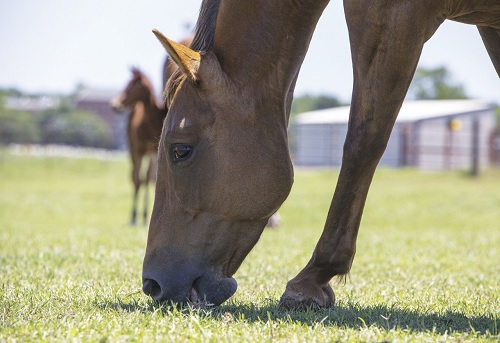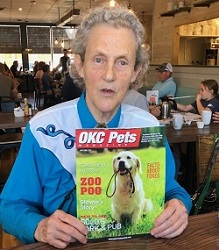Does it matter to you?

By Dr. Kris Hiney
Equine Extension Specialist | Oklahoma State University
The best environments for horses are those that most closely mimic their natural state. Grazing fresh pasture and continual turn out offer the horse freedom of movement, mental stimulation and natural feeding behavior. Continuous intake of smaller meals fits with the horse’s digestive physiology compared to meal feeding typical of confinement systems.
Economically, grazing offers a cheaper method to provide nutrients for the horse when compared to buying harvested forages and feeds. When combining adequate acreage with good pasture management, grazing can provide the majority, if not all, of most horse’s nutrient requirements. In fact, many horses can easily consume well over their needed caloric intake and become quite fleshy while grazing good pasture.
But first, what is “good pasture”? How many acres does it take to meet the nutritional needs of a horse? And what does good pasture management entail? To answer these questions, we first must address the way in which horses make foraging choices.
In order to understand pasture management, it is important to grasp the natural behavior and foraging patterns of the horse. Equine foraging patterns are often misunderstood, and can cause mismanagement of pastures or, even worse, a lack of any management technique at all. It is important that the horse owner identifies which foraging patterns and, thus, management system are most applicable to their scenario.
Grazing patterns of free-ranging horses versus pastured or restricted grazing horses differ greatly. For example, information gathered on feeding behavior in feral horses which routinely travel multiple miles per day will differ compared to horses which are confined to either large pastures or small paddocks.
Horses which are confined to traditional pastures prefer to graze in a pattern that is typically referred to as roughs and lawns or “patch grazing.” When looking at a typical pasture that is not intensely managed, you will see some areas where the foliage is closely cropped to the ground, “the lawns,” and other areas which appear to be much longer in growth, “the roughs.”
To a casual observer, it may appear the pasture contains adequate forage, yet the horses confined therein may actually be losing body condition due to an inadequate intake of nutrients. This is all too common in pastures with little to no management. Horses will continue to graze these lawn areas to the point the vegetation has lost the ability to recover and regrow. So while an owner may think a pasture has plenty of grass available, from the horse’s perspective, it may not.
This behavior, while it may not seem rational to a human, does match with the overall physiology of the horse. Shorter grasses are less mature; thus, they have a higher nutritive value. They have a higher digestibility, more protein and may even be higher in some vitamins and minerals. Despite the fact that more overall feed may be available to the horse in areas with taller, more mature plants, a horse will seek out these shorter, more nutritious plants.
The selective grazing pattern may be an evolutionary advantage for this hind gut fermenting species, which needs a higher protein quality than do ruminants. This is not all that dissimilar to the foraging patterns of other large herbivores, but horses seem to take it to an extreme. Horses, with their incisors, are much more capable of grazing grasses closer to the ground and can intensify this selection pressure on short grasses.
But do horses really make foraging choices based on their actual nutrient needs? In a study where horses were given choices between different grass heights that all met protein requirements, the horses selected the grasses which would provide overall greater intake. Essentially, one bite of taller grass resulted in more ingested feed and could allow for faster ingestion of energy. However, if the quality of the vegetation differed, horses began to make rather interesting choices. When protein quality lowered, so that it was only at or below their requirements, horses shifted to foraging choices that would supply their protein requirement but lowered their overall energy intake.
As maturity increased in the taller swards, this preference for shorter swards of higher nutrient content, but less overall available forage, increased. It appeared that horses were able to forage selectively to meet specific needs. If we think about this physiologically, it makes sense. Horses can mobilize fat stores to supply energy needs but need to ingest specific amino acids in order to synthesize body proteins. Thus, protein intake may be a higher priority than overall energy intake.
Not only do horses make grazing choices according to feed selection, but also to avoid grazing near feces. Horses confined to pastures typically exhibit what is known as latrine behavior, or repeatedly using the same areas for defecation. The vegetation in these areas grows quite tall as the horse refuses to use these areas for foraging. This behavior may confer the advantage of prevention of parasite infestation as most infective worm larvae are found within 1 meter of fecal piles.
This combined avoidance of both tall grass and grazing near feces is what creates the roughs, which may represent almost 50% of a pasture. Unfortunately, an owner cannot choose a part of the pasture to create a latrine area. The initial selection of a latrine area does not appear to be due to any difference in vegetative species or palatability; it is simply due to avoidance of grazing near fecal material.
In comparison, free ranging horses and ponies simply defecate where they happen to be grazing, then merely continue walking forward. Presumably, this is because there is enough grazing area available to avoid grazing near feces. In the study mentioned above, there was also low animal density, between about 6.5 acres to 19 acres per animal. These animals were also grazing in rather poor nutritive value areas, so their feeding decisions may have had more to do with nutritive decisions or pressures rather than grazing near eliminative areas.
Therefore, if you are fortunate enough to have extremely large pastures or ranges, latrine behavior may not be a concern for you. Alternatively, when horses are presented with small paddocks with uniform grass height, they also do not show any specific latrine behavior, but rather defecate throughout the area rather homogenously. This allows a much more uniform distribution of foraging.
As we continue to learn more about the foraging patterns and the choices horses make while grazing, we can make better choices for pasture management. To maximize production of our pastures, we need to understand the choices horses make and how we can manipulate those choices to our advantage.

